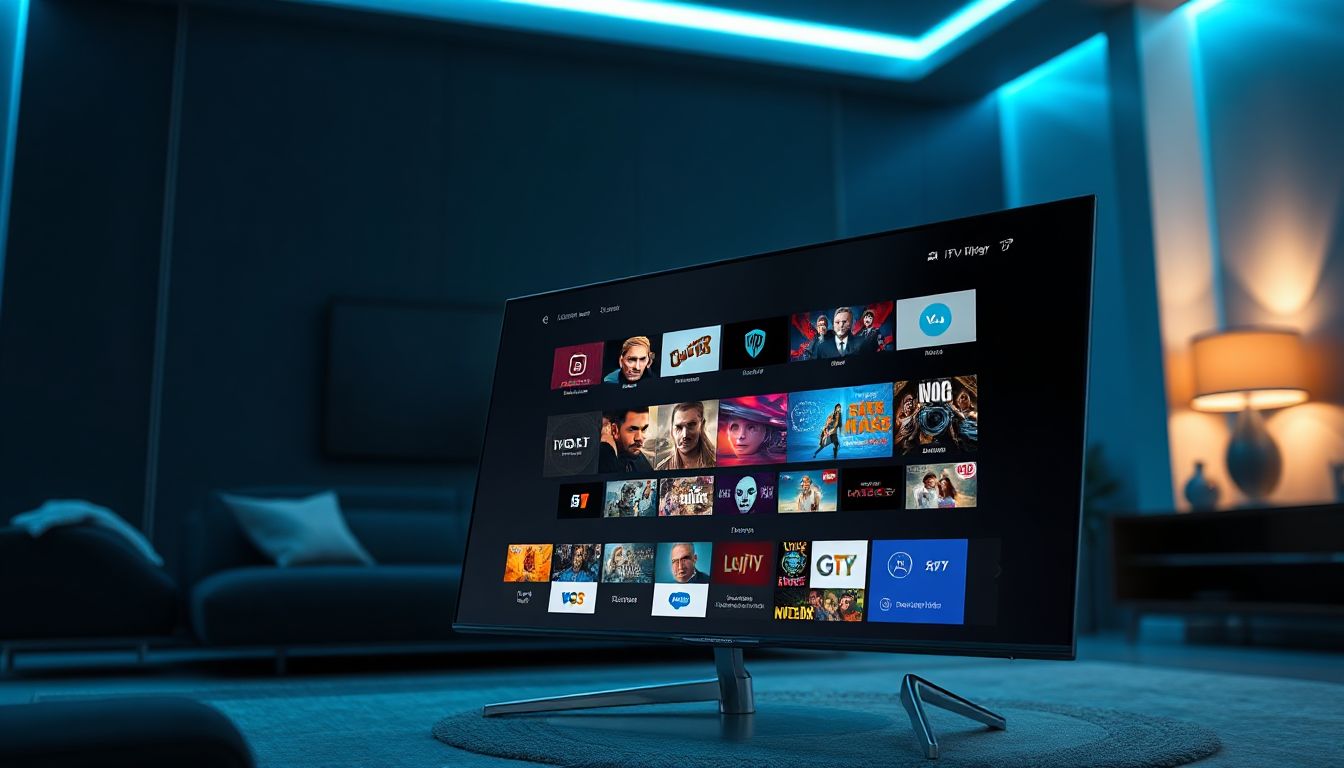IPTV stream players in 2026 Technology: Guide to IPTV Expect

IPTV stream players in 2026 imagine kicking back after a long day, flipping on your TV, and diving into crystal-clear live sports or your favorite shows without a single glitch.
That’s the promise of IPTV stream players in 2026 tech by 2026. Gone are the days of bulky cable boxes and fuzzy signals from satellites. Internet Protocol Television, or IPTV, has become the go-to way we watch media at home. It streams content over your broadband connection, offering endless choices on demand.
This shift means more freedom for you. No more waiting for scheduled broadcasts or dealing with limited channels. Providers beam everything straight to your screen via apps and devices. But here’s the key: the real magic happens through specialized IPTV stream players in 2026 stream players. These tools—whether software or hardware—handle the heavy lifting, turning raw streams into smooth, enjoyable viewing. As we look ahead to IPTV stream players in 2026 , expect these players to evolve big time, making your entertainment setup smarter and more reliable.
Section 1: Understanding the 2026 IPTV Landscape
Defining Next-Generation IPTV Protocols
IPTV stream players in 2026 protocols will rule the way we stream. Think of advanced versions of HLS and MPEG-DASH taking center stage. These setups break video into small chunks, sending them over the internet for steady playback. Improvements mean less buffering, even during peak hours.
Low-latency tech will shine for live events. Picture watching a soccer match where the action on screen matches the roar of the crowd in real time. Delays drop below a second, thanks to smarter edge servers closer to your home. IPTV stream players in 2026 will support these protocols out of the box, ensuring you catch every goal without frustration.
Experts predict over 80% of streams will use these upgraded formats by then. That jump comes from better compression, squeezing more quality into your bandwidth. If you’re into live TV, this means sharper images and quicker responses in your player app.
The Interoperability Mandate: Devices and Ecosystems
In IPTV stream players in 2026 , your gadgets will talk to each other like old friends. Smart TVs from brands like Samsung and LG will bake in IPTV stream players in 2026 support, ditching the need for extra apps. Dedicated boxes, too, will plug right into any setup, thanks to universal standards.
Open protocols win over closed systems here. No more locked-in ecosystems that trap you with one brand. This openness lets you mix a Roku stick with your Android phone for the same IPTV stream players in 2026 experience. It broadens access, especially for folks in rural spots with spotty service.
Manufacturers push this for market share.IPTV stream players in 2026 expect most devices to handle M3U playlists and EPG data without hiccups. That smooth flow across ecosystems keeps your viewing flexible and frustration-free.
Security and DRM in Future IPTV Players
Content creators guard their stuff tight, and IPTV stream players in 2026 will feel it. Digital Rights Management, or DRM, gets an upgrade with stronger encryption. This stops pirates from stealing streams, but it also means legit players must play nice with these rules.
You’ll notice apps asking for verification more often, like linking to your account for premium channels. It protects your data too, with built-in firewalls against hacks. Legit services like those from major networks will use Widevine or PlayReady levels three and up for secure playback.
The upside? Fewer shutdowns from legal woes. Users get stable access to big leagues like HBO or ESPN. Just pick players certified for these standards to avoid black screens mid-show.
Section 2: Essential Features of High-Performance IPTV Stream Players (2026)
AI-Driven Interface and Personalization
Smart algorithms will make your IPTV stream players in 2026 r feel like it reads your mind. Machine learning scans your watch history to suggest shows before you search. No more endless scrolling through menus.
Features like auto time-shifting let you pause live TV and pick up later, based on your routine. It might even build a custom channel list, mixing news with comedies just for you. By 2026, this tech cuts down search time by half, per industry reports.
Ever wished your TV knew you loved action flicks on weekends? These players deliver that. They learn from your skips and repeats, refining options over time. It’s like having a personal DJ for video content.
4K/8K Streaming and High Dynamic Range (HDR) Optimization
Ultra-high-def streams demand power, and 2026 players will pack it. Support for AV1 codecs means smaller file sizes with stunning detail. Your screen pops with colors in HDR, from deep blacks to bright highlights.
Hardware needs beefy processors to decode without lag. Look for devices with at least quad-core chips rated for 60fps playback. Software tweaks ensure smooth frame rates, even on older setups with updates.
To check your gear, run a bandwidth test—aim for 25Mbps for 4K, 100Mbps for 8K. Update your player’s firmware regularly. This way, you future-proof without buying new stuff every year. Test streams from free sites to see if your current box handles it.
- Tip 1: Enable hardware acceleration in settings for better efficiency.
- Tip 2: Pair with a 4K TV that supports Dolby Vision for max impact.
- Tip 3: Monitor heat—overloaded players stutter, so good airflow matters.
Seamless Multi-Screen and Cloud Synchronization
Switch devices mid-watch without missing a beat. IPTV stream players in 2026 sync via the cloud, resuming exactly where you left off. Start on your TV, grab your tablet for the kitchen scene.
This works through unified accounts across apps. Your progress saves in real time, no manual saves needed. It’s perfect for families, where one person pauses and another jumps in.
Cloud magic means no local storage hassles. Streams pull from servers, keeping quality consistent. If your Wi-Fi dips, the player buffers smartly to avoid jumps.
Section 3: Hardware vs. Software Players: The 2026 Showdown
Dedicated IPTV Streaming Devices (Sticks and Boxes)
Specialized boxes shine IPTV stream players in 2026 for tough streams. They have custom chips for decoding high-bitrate video, outpacing phone apps. Remote controls feel intuitive, with voice search baked in.
These sticks plug into any HDMI port, turning old TVs smart. Trends show ARM-based processors optimized for 8K, handling multiple streams at once. You get fewer crashes during marathons.
Compared to built-ins, they update faster. If your TV lags on new protocols, a $50 box fixes it quick.
The Dominance of Integrated Smart TV Applications
Big screens lead the pack by 2026. Samsung and Sony TVs run native IPTV stream players in 2026 apps that rival external gear. No cords or setups—just download and go.
Manufacturers boost RAM and GPUs for smooth play. This sidelines boxes for casual users, saving space and cash. Updates come via TV firmware, keeping things fresh.
Still, for power users, apps might lack depth. But for most, it’s plug-and-play bliss.
Cross-Platform Compatibility: Android TV, Apple tvOS, and Beyond
Android TV edges out with open apps, supporting tons of IPTV strehttps://smartkingpro.online/
am players in 2026 . It runs smooth on boxes like Nvidia Shield, with easy sideloading. Apple tvOS locks down more, but excels in secure, polished playback.
Performance? Android handles custom lists better, while Apple shines in ecosystem ties like AirPlay. Fire TV sits in the middle, strong on Amazon content.
Pick based on your phones—Android for flexibility, Apple for tight integration. All support key protocols by 2026, but test apps for your needs.
Section 4: Optimizing Your IPTV Viewing Experience
Network Requirements for Future Streaming Loads
Fast internet is non-negotiable for IPTV stream players in 2026 . You need 50Mbps minimum for 4K, up to 200Mbps for 8K without stutters. Wi-Fi 6E or wired Ethernet keeps it steady.
Upgrade your router if it’s old—look for ones with MU-MIMO for multiple devices. Home setups with mesh networks spread signal even in big houses.
Test your speed during evenings when networks peak. If it dips, prioritize streaming on a dedicated band.
Choosing the Right Subscription Model
Go legit for peace of mind. Aggregators like YouTube TV bundle channels with one bill, stable and ad-light. M3U services offer cheap lists, but they flicker if providers change.
Weigh costs: legit ones run $50-80 monthly, with guarantees. URL-based can save bucks but risk shutdowns. Check reviews for uptime.
Stick to services with EPG and catch-up features. It ensures your IPTV stream players in 2026 player runs full tilt.
Troubleshooting Common Playback Failures
Buffering hits when bandwidth chokes—close other apps and restart your router. For codec issues, update your player to the latest version.
EPG sync fails? Clear cache and re-add your playlist. If streams black out, verify DRM compatibility.
- Step 1: Check connections—cables firm, Wi-Fi strong?
- Step 2: Test on another device to isolate the problem.
- Step 3: Contact support with logs for quick fixes.
These steps fix 90% of glitches, keeping nights smooth.
Section 5: Emerging Innovations Shaping IPTV in the Late 2020s
The Role of Immersive Media (AR/VR Integration)
IPTV stream players in 2026 heads into AR and VR by 2026. Players overlay stats on live games via glasses, pulling streams in real time. Watch a concert with virtual crowds around you.
Apps integrate with headsets like Meta Quest, blending flat video with 3D elements. It amps up education too—history docs become walk-throughs.
Early tests show low adoption, but prices drop fast. Your stream player becomes a portal to new worlds.
Decentralized Content Delivery Networks (DCDN)
Peer-to-peer nets boost speed without big servers. In IPTV stream players in 2026 , DCDNs share loads among users, cutting lag in remote areas.
Blockchain adds trust, verifying streams without middlemen. Players tap these for resilient playback during outages.
It’s like borrowing from neighbors for a block party—faster, cheaper delivery. Expect hybrid models mixing traditional and decentralized for best results.

Conclusion: Future-Proofing Your 2026 Entertainment Hub
IPTV stream players in 2026 bring smarts, sharp visuals, and easy connections to your daily watch. We’ve seen protocols tighten up, AI personalize your picks, and devices blend into one smooth system. Hardware and software battle it out, but the winner serves you best.
